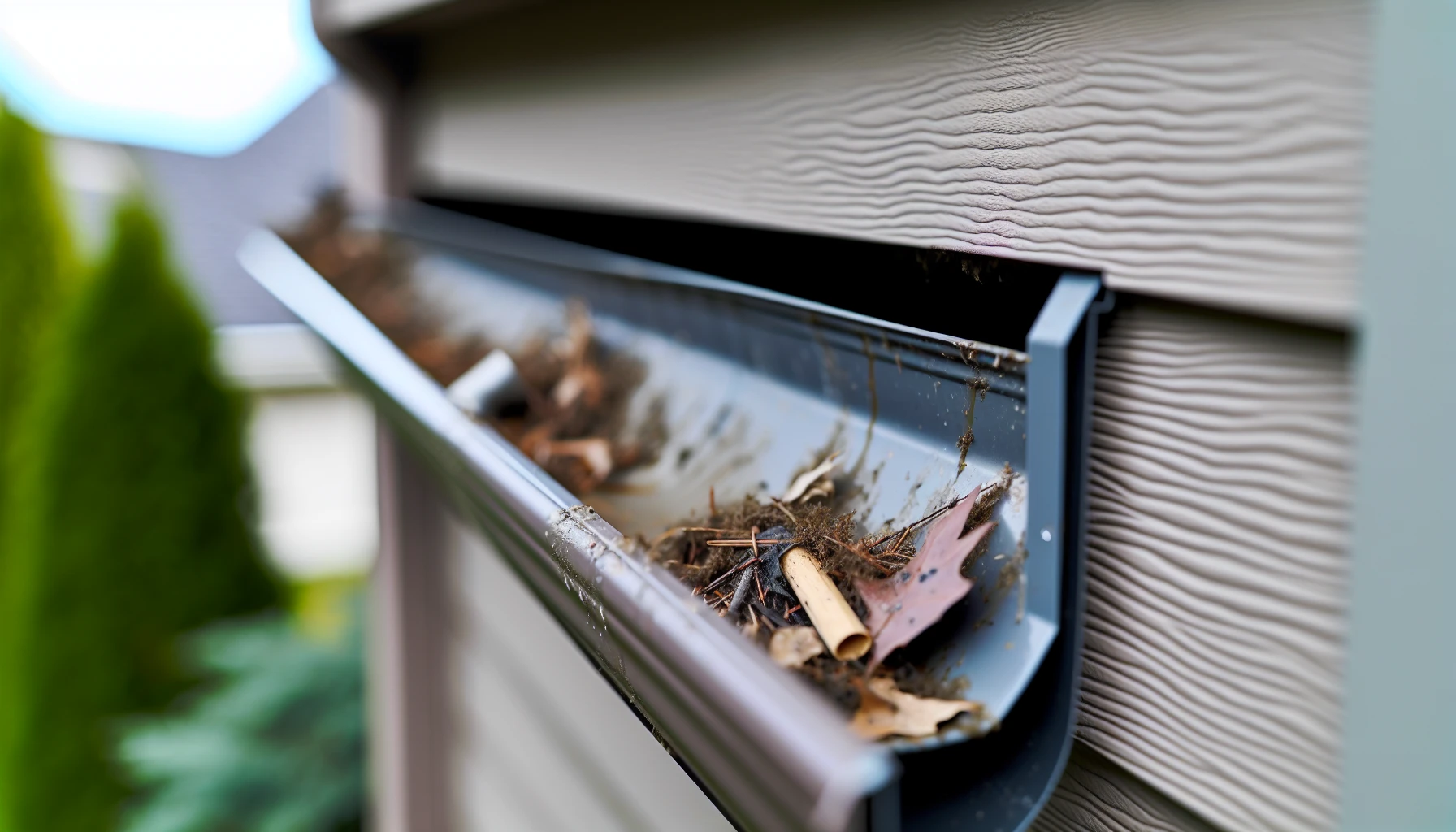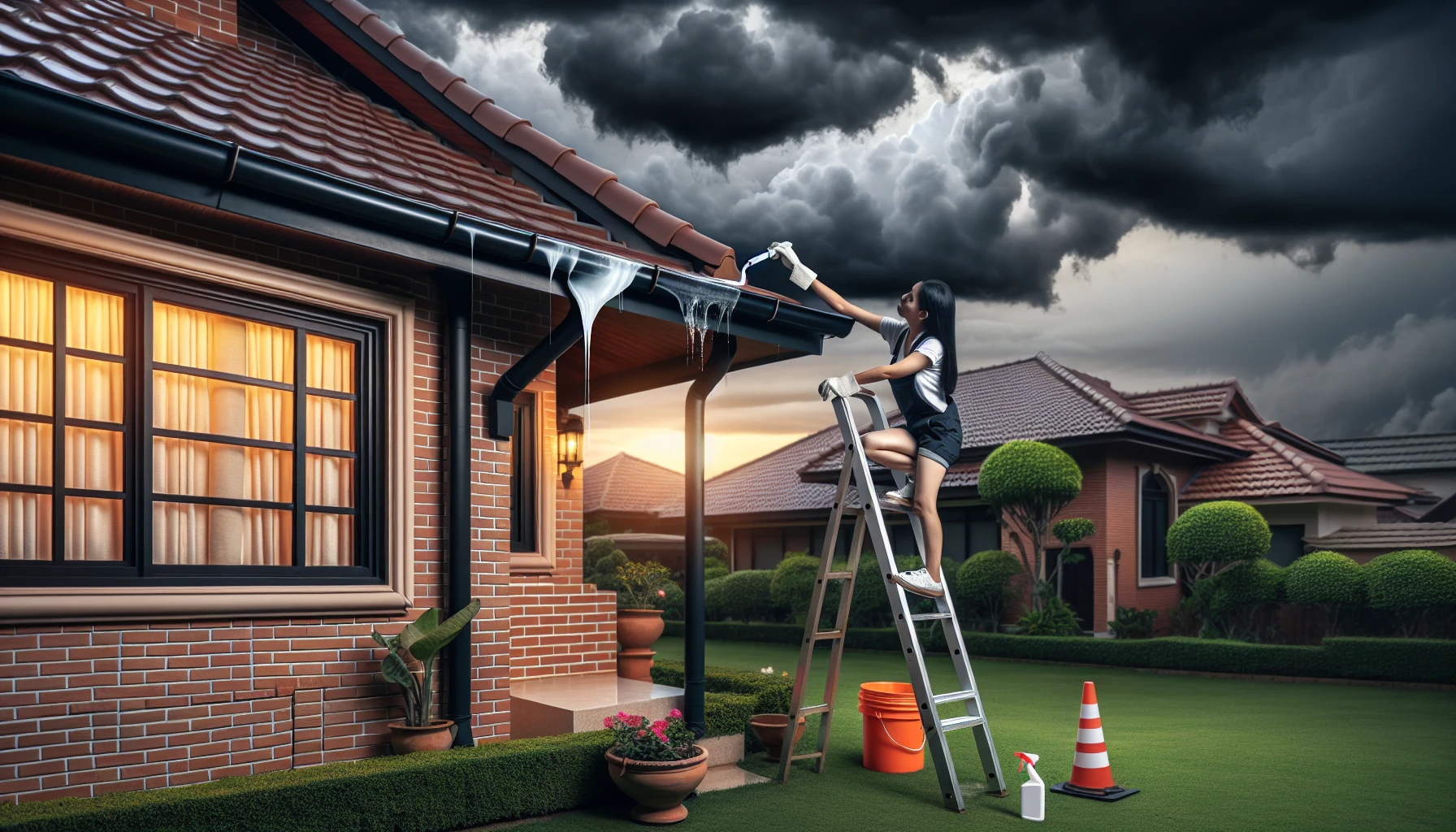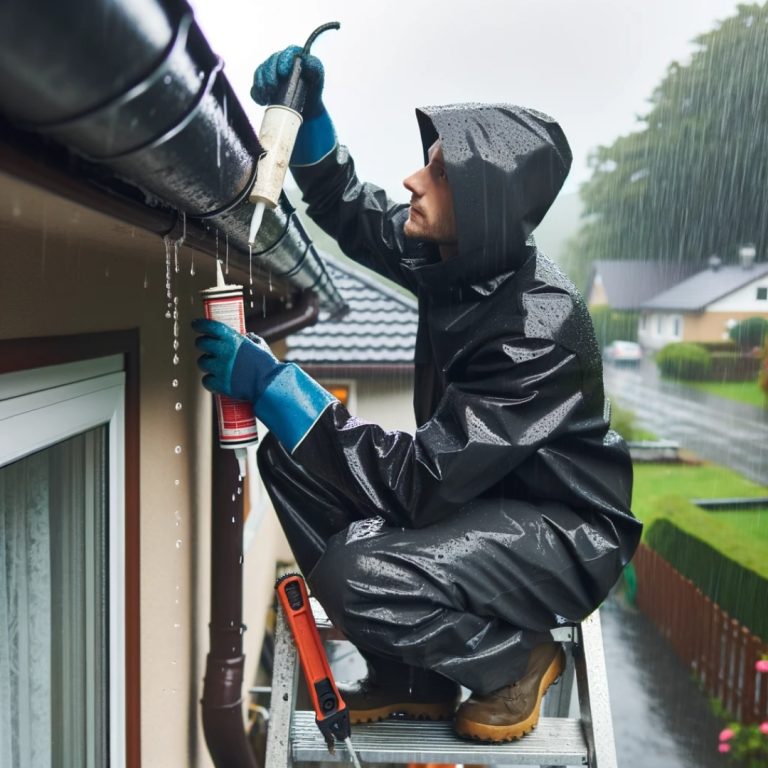Picture a rainy day, and you’re cozily wrapped up in your favorite blanket, enjoying the soothing sound of raindrops pattering against your window. But suddenly, you hear the dreaded dripping noise coming from outside: your leaking gutters are causing trouble. Left unchecked, leaky gutters can cause costly damage to your home. Fortunately, understanding the causes of gutter leaks and how to repair leaking gutters can save you time, money, and headaches down the road.
Key Takeaways
- Identify the causes of leaky gutters and roofs, such as clogs, holes, and separated seams.
- Use metal flashing & gutter sealant to patch larger holes in gutters for a durable solution.
- Install gutter guards & conduct regular inspections for preventative maintenance measures.
Identifying the Culprits Behind Leaky Gutters

Leaky gutters and a leaky roof typically have three main causes: clogs, holes, and separated seams. Understanding how to identify these typical issues enables you to tackle the problem effectively and avert further harm to your home.
The following sections will provide more detailed information on each of these problem areas and offer guidance on how to address them directly.
Clog Clear-Out
Clogged gutters can cause water to overflow, which may appear as a leak. To clear out clogs and ensure proper water flow, start by removing large debris like leaves and twigs manually. After that, use a trowel or gutter scoop to remove any compacted debris and clean the downspout strainers.
Finally, flush the gutters and downspouts with a garden hose to confirm they are free from obstructions. This process helps avoid mistaking spillover for a leak, allowing you to focus your attention on actual leaks that may be present.
Hole Hunt
A thorough inspection of your gutters for cracks and holes plays a significant role in preventing water damage. If you find any, you can seal them with silicone or rubber gutter caulk to extend the lifespan of your gutters. To do this, clean the area around the hole, removing any dirt, debris, or old caulk.
Apply a thin, even bead of caulk along the edges of the hole, and smooth it out with a putty knife to ensure proper adhesion to the gutter surface. Allow the caulk to dry and cure according to the manufacturer’s instructions before exposing it to water or other elements.
Seam Scrutiny
Gutter seams are another common source of leaks, especially if they haven’t been adequately sealed. To repair separated seams, follow these steps:
- Remove old sealant and ensure the area to be sealed is completely dry.
- Apply silicone caulk or sealant along the seam.
- Smooth out the sealant for a watertight seal.
Properly sealed gutter seams will help prevent future leaking gutter seams issues, as well as roof leaks, and protect your home from water damage. Hiring a professional gutter company ensures that the job is done right.
Step-by-Step Leak Repair for Rain Gutters

Having understood the common causes of gutter leaks, let’s move on to learning how to fix them. The upcoming sections will offer step-by-step instructions for sealing minor leaks, patching holes, and tightening loose gutters.
By following these steps, you can effectively address gutter issues and protect your home from the costly consequences of unattended leaks.
Sealing Small Leaks
To seal small leaks in your gutters, start by thoroughly cleaning the area surrounding the leak using a wire brush or scrub brush to remove any rust or debris. Ensure the area is completely dry before applying the waterproof sealant.
Apply a line of waterproof sealant along the inside of the gutter where it meets the end cap or along the small hole or crack. Smooth out the sealant to cover the entire leak and form a watertight seal. Adhere to the manufacturer’s instructions for drying and curing time to ensure the best results.
Patching Holes
For larger holes in your gutters, you’ll need to patch them using metal flashing and gutter sealant. First, clean the area around the hole using a wire brush or sandpaper to remove any rust or debris. Ensure the area is dry before proceeding with the patching.
Cut a strip of metal flashing wide enough to completely cover the hole, and apply roofing cement to the damaged area. Embed the flashing material into the roofing cement, and feather the edges to ensure smooth water flow. This method provides a durable and long-lasting solution for larger holes.
Fixing Loose Gutters
Loose gutters can cause leaks and damage to your home’s structure. To fix them, start by tightening or replacing any loose fasteners. If the gutter still appears loose, consider installing fascia hanger brackets to ensure the gutters remain secured to the house.
Also, ensure the gutter maintains a ¼-inch drop towards the downspout for optimal drainage. Well-secured gutters will ward off leaks and shield your home from water damage.
Preventative Measures to Keep Gutters in Good Shape

Preventative measures play a pivotal role in maintaining the condition of your gutters and warding off leaks. Implementing strategies such as the installation of gutter guards, routine inspections, and proactive maintenance can extend your gutters’ lifespan and shield your home from expensive damages.
The upcoming sections will delve into these preventative measures in greater detail.
Gutter Guards Installation
One of the most effective ways to prevent gutter clogs is by installing gutter guards. There are various types of gutter guards available, including:
- Reverse-curve guards
- Stainless steel mesh guards
- Foam guards
- Screen guards
By installing gutter guards, you can reduce the need for constant manual cleaning and help prevent leaks caused by clogs.
Research and compare different types of gutter guards to find the best option for your home and needs.
Regular Inspections
Conducting regular inspections of your gutters and downspouts is essential to identify and address small issues before they become larger, more costly problems. Inspect your gutters at least twice a year, particularly after the autumn season, when leaves and debris are more likely to accumulate.
During inspections, look for signs of wear and damage in your gutter system, such as:
- cracks
- rust
- open gaps
- holes
Addressing these issues promptly will help fix leaking gutters, maintain their integrity, and prevent leaks.
Proactive Maintenance
Performing proactive maintenance on your gutters can extend their lifespan and prevent leaks. This includes cleaning your gutters regularly, painting them every five to 10 years, and sealing any cracks or holes with gutter sealant.
By taking these steps, you can keep your gutters in good shape and protect your home from water damage.
When to Consider New Gutters
A point might arrive when gutter repairs no longer suffice, and gutter replacement becomes a necessity. This could be due to factors like:
- age
- wear
- ongoing damage
- the wish to upgrade to a more efficient system
The upcoming subsections will cover the factors that might prompt you to contemplate new gutters and the advantages of enhancing your gutter system.
Age and Wear
Assessing the age and wear of your gutters is key, as they might require replacement after 20 to 30 years or if they exhibit signs of substantial damage. Different gutter materials have varying lifespans, with aluminum gutters lasting around 20 years and steel gutters around 30 years. In addition, extreme weather conditions and temperature fluctuations can affect the longevity of your gutters.
Keep an eye on the physical indications of wear, such as rust, plant growth, and sagging, to determine when it’s time for a replacement.
Continuous Damage
If your gutters continue to experience damage and leaks despite regular maintenance and repairs, it might be time to consider replacing them. Persistent damage such as visible cracks, corrosion, and streaking can be a sign that your gutters have reached the end of their lifespan.
Replacing damaged gutters with new ones made of galvanized steel or vinyl gutters can protect your home from costly water damage and provide peace of mind. Don’t forget to install gutter end caps for a complete and efficient system.
Upgrade Options
When considering new gutters, explore upgrade options such as seamless gutters or larger downspouts to improve efficiency and reduce the risk of leaks. Seamless gutters require less maintenance and provide a sleek, modern appearance. Larger downspouts can handle higher volumes of water flow, preventing clogs and efficiently draining water away from your home’s foundation.
By upgrading your gutter system, you can enhance its performance and protect your home from potential water damage.
Summary
In conclusion, maintaining your gutters is crucial for protecting your home from costly water damage. By identifying common causes of leaks, performing step-by-step repairs, and implementing preventative measures, you can extend the life of your gutters and ensure their optimal performance. Don’t wait for the next rainy day to address your gutter issues; take action now to safeguard your home and enjoy the peace of mind that comes with well-maintained gutters.
Frequently Asked Questions
How do I stop my gutters from leaking?
To stop gutters from leaking, first clear the gutter of any debris, clean the joint with a wire brush, and then apply a generous amount of gutter sealant to the joint. Spread the sealant evenly and scrub the downspout joints with a plastic scouring pad before replacing any rubber gaskets on vinyl or PVC gutters.
Is a leaking gutter a problem?
Yes, a leaking gutter can be a significant problem as it can damage the windows, home exterior or foundation if not repaired or cleaned. It is important to take action as soon as possible in order to avoid expensive roof repairs.
What is the average lifespan of gutters?
The average lifespan of gutters is between 20 and 25 years.
Can I seal small leaks in my gutters during rainy weather?
Yes, you can temporarily seal small leaks in your gutters during rainy weather by using a water-resistant sealing product or gutter tape.
What are the benefits of installing gutter guards?
Gutter guards help protect gutters from debris buildup and clogs, reducing the need for manual cleaning and preventing potential leaks.
